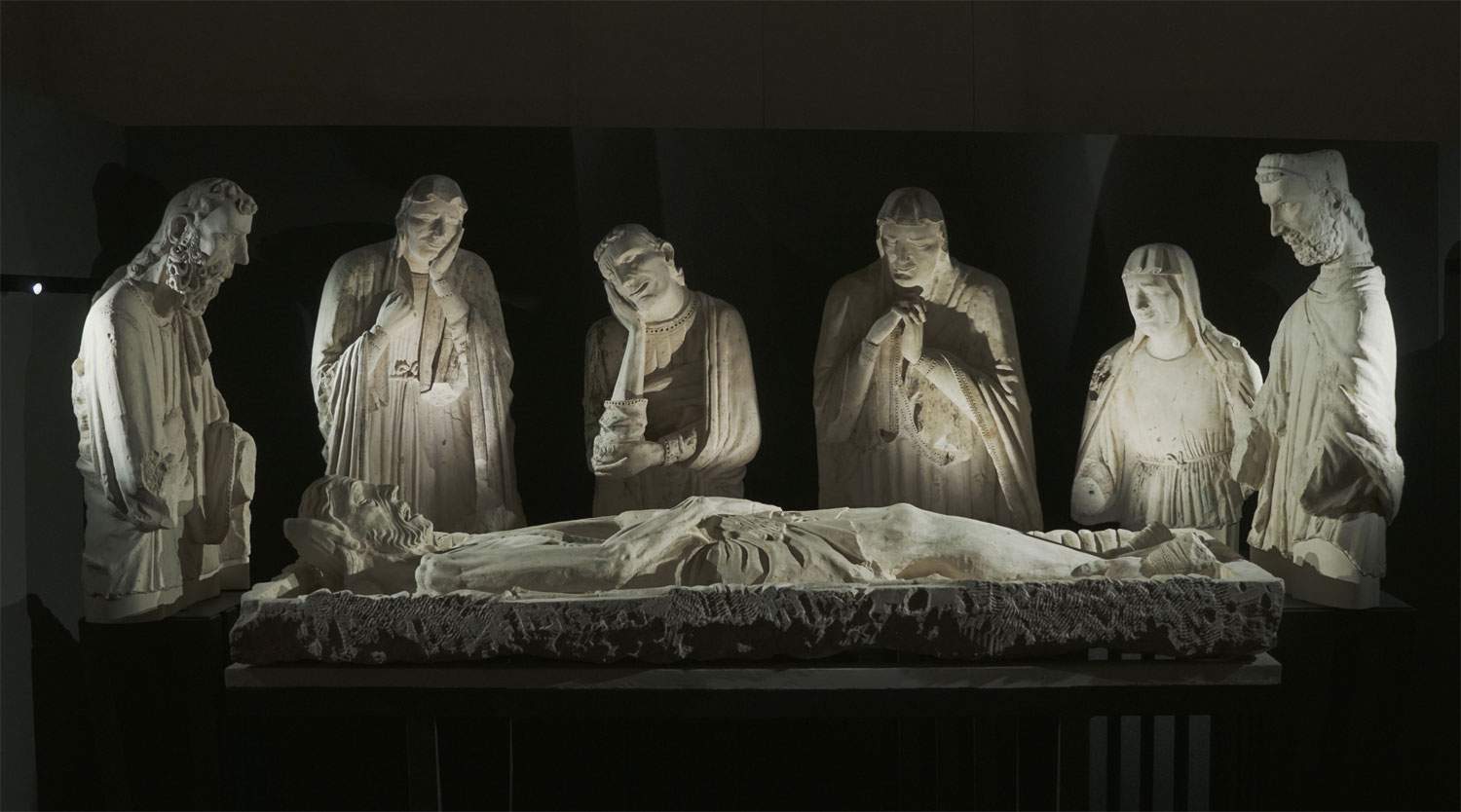After an eight-year restoration in the laboratories of theOpificio delle Pietre Dure in Florence, the precious Lamentation over the Dead Christ from Caprino Veronese, where it is kept in the local Museo Civico in Palazzo Carlotti, has returned home. The 14th-century sculptural group, attributed to the Master of St. Anastasia, was handed back to the city in an official ceremony as part of a conference attended by Luca Fabbri, Art Historian OfficerArt of the Superintendence of Verona, Rovigo and Vicenza, Maria Cristina Improta (former Director of the Stone Materials Restoration Sector of the Opificio delle Pietre Dure), Riccardo Gennaioli (Director of the Stone Materials Restoration Sector of the Opificio delle Pietre Dure) and Paola Lorenzi and Franca Sorella (Restorers Opificio delle Pietre Dure, Stone Materials Restoration Sector).
The complex of statues, characterized by intense pathos and expressionism aimed at arousing strong emotions in the faithful, dates back to the first half of the 14th century and comes from the Church of the Holy Sepulchre in Caprino Veronese. From there in 1980 it was transferred for security reasons to the Villa Carlotti Civic Museum in Caprino. Attributed to the Master of St. Anastasia, later identified as Rigino di Enrico, although no documented links are known of him to any of the works that have been assigned to him, the sculptural group consists of Christ laid in the shroud, surrounded by six life-size mourners, although all the statues are resected to torso height. Central to this representation is the dead body of Jesus, whose face becomes the narrative of suffering as he expresses both the anguish and the human tragic nature of death itself. At the heads he is supported by Joseph of Arimathea and Nicodemus, who have the lower parts of his limbs and forearms removed. Mourning Jesus are sculptures depicting the presence of John, the favorite apostle, his mother and two pious women whose identities are known through the Gospel of John, which indicates the presence of Our Lady, Mary of Cleophas and Mary Magdalene: “Stabant autem iuxta crucem Jesu, Mater eius et soror Matris eius Maria Cleophae, et Maria Magdalenae.”
The first written documentation testifying to the presence of the sculptural group in the Oratory of the Holy Sepulchre in Caprino Veronese is linked to a note by historian Monsignor Giuseppe Crosatti, who in the early twentieth century, in a monograph on Bardolino, left a note about the presence of the Lamentation in that church, albeit placed differently: behind the high altar. The Compianto remained here until 1981, when it was moved, for security reasons, to a room in Carlotti Palace. In fact, it is not certain that the Lamentation was from its origin in the Church of the Holy Sepulcher. The figures that are at the heads of Jesus, as mentioned, today show conspicuous impairments, very different, therefore, from what they presumably must have looked like originally.
Restoration of the group had begun in 2013, when the Soprintendenza Archeologia, Belle Arti e Paesaggio for the Provinces of Verona, Rovigo and Vicenza, reported the conservation situation of the sculptural group to the then director of the Opificio, Marco Ciatti, who granted the Institute’s willingness to take charge of the complex restoration work. The restorers of the Opificio’s stone materials sector have been engaged since the sculptural group’s arrival in Florence in November 2013 in planning an in-depth diagnostic campaign to study the constituent material, artistic techniques and previous interventions. For this, some collaborations with important research centers were activated. The complex restoration work that followed led to the recovery and stabilization of the state of conservation of the sculptural masterpiece.
During the work, the three-dimensional relief of the lower parts of the sculptures was arranged to recover the lost, resected, support bases over time. The new bases, perfectly juxtaposed to the stone material, were made by numerical control milling in synthetic material and finally grouted to tone. Finally, the Opificio’s Climatology and Preventive Conservation service defined the environmental parameters of the new exhibition venue, which are crucial for the conservation of the Lamentation over the Dead Christ.
Regarding the removal of the lower parts and forearms, this may be due to the placement of the statues in the niche at the back of the high altar of the Church of the San Sepolcro, where they appeared since the early 1900s. It is not possible to ascertain from the known sources either the possibility that the sculptural group came from another church or that it was in the same oratory, but in another location. However, it is presumable that, as a result of the work that took place in the church between 1761 and 1768, Joseph D’Arimathea and Nicodemus suffered the known impairments. One of the special features of this inauguration and of the Lamentation in Caprino Veronese is related to the Crown Ways of which the Lamentation over the Dead Christ in Caprino Veronese is a stage.
 |
| After eight years, restoration of Caprino Veronese's tragic Lamentation ends |
Warning: the translation into English of the original Italian article was created using automatic tools. We undertake to review all articles, but we do not guarantee the total absence of inaccuracies in the translation due to the program. You can find the original by clicking on the ITA button. If you find any mistake,please contact us.